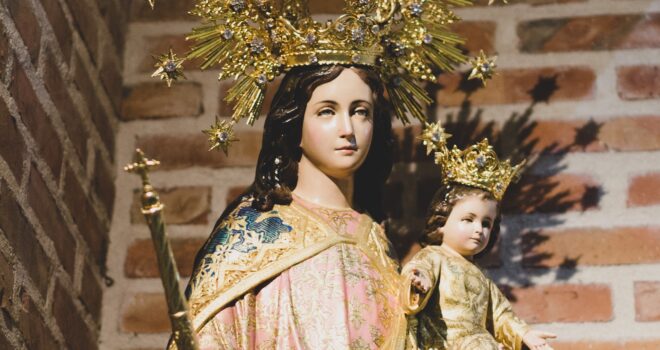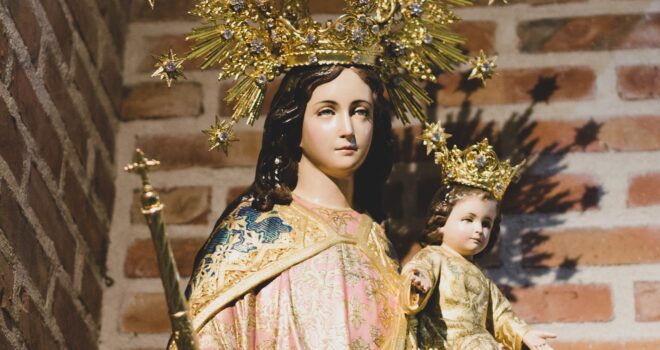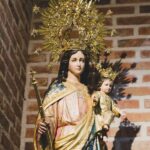We begin answering this important question by posing one of much lesser importance. Why did Mary ride on a donkey in her flight to Egypt? The answer, my dear, indulgent readers is that she had given her FIAT to the Lord. What use God could possibly have with an Italian-made car shall be left to the imagination.
For those who may not be familiar with what the letters FIAT signify, they refer to Fabbrica Italiana Automobili Torino. Founded in 1899, this Turin-based company has become since then, a symbol of Italy’s technological and creative enterprise, which, as it is reported, has “changed the country and the history of global mobility forever.”
Mary’s fiat (Latin for “let it be done”) has changed the world far beyond “global mobility.” It has dramatically changed the lives of human beings and society in general as no one before or after has done by bringing Christ into the world. She gave permission for the world’s greatest moral revolution to begin.
There are some theologians who argue that Mary’s fiat could not have been genuine since she, a young girl who knew very little about the world, would have been afraid of rejecting God’s invitation. Therefore, she must have felt coerced into obeying Him because she believed that she had no other choice. She must have been intimidated by the Divine offer. God knew in advance what her decision would be which is why he selected someone who could not say “no.”
On the other hand, it is blasphemous to think that God is a bully. Mary was prayerful and developed a love for God which included her trusting Him. Love prepares itself to accept Love even though that love may bring great difficulties and hardships. In his book The Four Loves, C. S. Lewis states that “To love at all is to be vulnerable. Love anything and your heart will be wrung and possibly broken. If you want to make sure of keeping it intact you must give it to no one, not even an animal. Wrap it carefully round with hobbies and little luxuries; avoid all entanglements. Lock it up safe in the casket or coffin of your selfishness. But in that casket, safe, dark, motionless, airless, it will change. It will not be broken; it will become unbreakable, impenetrable, irredeemable. To love is to be vulnerable.”
Did Mary know beforehand, what she was in for? Did she anticipate becoming the Lady of Sorrow, Mater Dolorosa, having her heart pierced, witnessing the crucifixion of her Son. Had she seen these things in advance, surely she would not have offered her fiat. She must have had in mind only the good things that, being the mother of our Savior, she would enjoy without taint. But her love was inseparable from her trust. She trusted that, in the final analysis, whatever difficulties she would endure would dissolve in the presence of lasting joy.
Raniero Cantalamessa, Pope John Paul II’s theologian, stated the following in his book, Mary Mirror of the Church: “Mary’s fiat was a free act; rather, it was the first really true free act since the beginning of the world, because true freedom does not consist in doing or not doing what is good but in freely doing what is good; freedom to freely obey and not freedom to obey or not obey God”.
Mary’s freedom implies more than saying “yes” or “no”. It was a freedom to embrace freely all that her initial fiat would bring into play. Her freedom was both human and divine; human by nature, divine by grace.
There are three great fiats in history. The first is when God said “Fiat lux” (let there be light). This fiat brought the world into existence. The next was Mary’s fiat (Fiat mihi secundum verbum meum – “let it be done unto me according to Your word”). The third fiat is that of Jesus in the paschal mystery, His saying yes to the Will of the Father (Luke 22-42).
But there is a fourth fiat, one that that is contained in the Our Father. One that we can say every day: “Thy will be done.” When we utter this fourth fiat (Fiat voluntas Tua – “Thy Will be done”). In reciting this prayer we are repeating Mary’s fiat, welcoming God’s Will into our daily lives. Mary’s fiat continues the work of creation. Our fiat adopts the fiat of Mary. “Yes” to creation; “yes” to the Incarnation; and “yes” to living in accord with God’s Will. Christianity could not be more affirmative. This concatenation of yeses stands triumphantly against “I will not serve”.
Karl Stern, a distinguished psychiatrist and convert to the Catholic Church, has said of Mary that the stillness in the nod of assent was equalled only by the original freedom of the creative act.” He goes on to say that “The ‘Thy Will be done,’ that unconditional Yes which we pronounce every day in prayer and which leads to a thousand little incarnations, at one central moment of history, was a unique manifestation of freedom that led to the Incarnation.”
Mary’s assent was truly free in that she accepted everything that was to emerge from her assent. Because it was unconditional, it was free in the highest sense of the word. Her freedom was momentous in its significance and offers us a model of freedom that each of us should seek to imitate in our daily lives.
Photo by Jomarc Nicolai Cala on Unsplash












